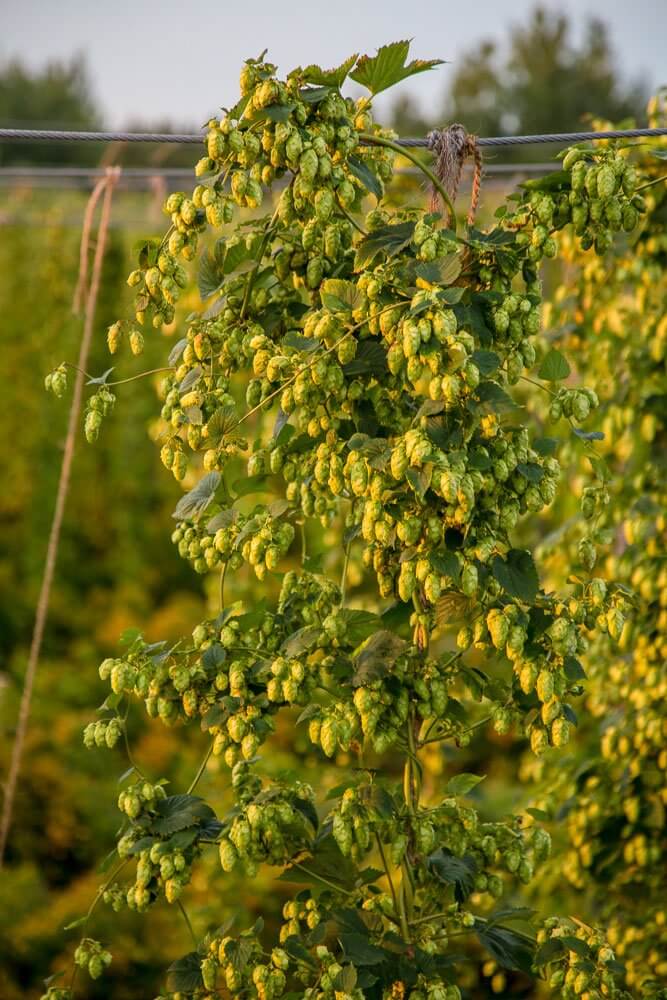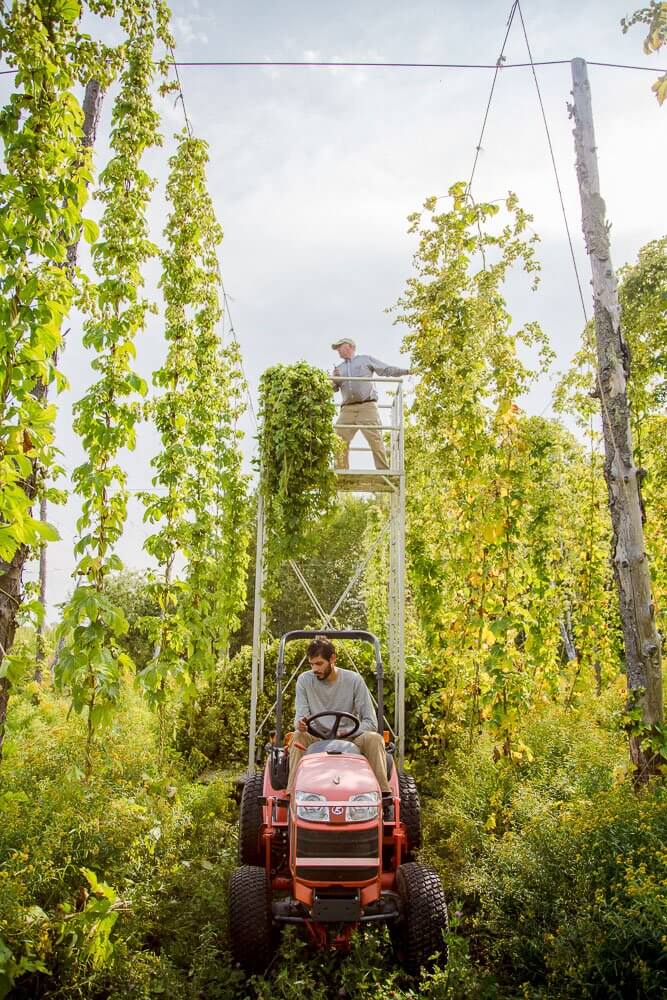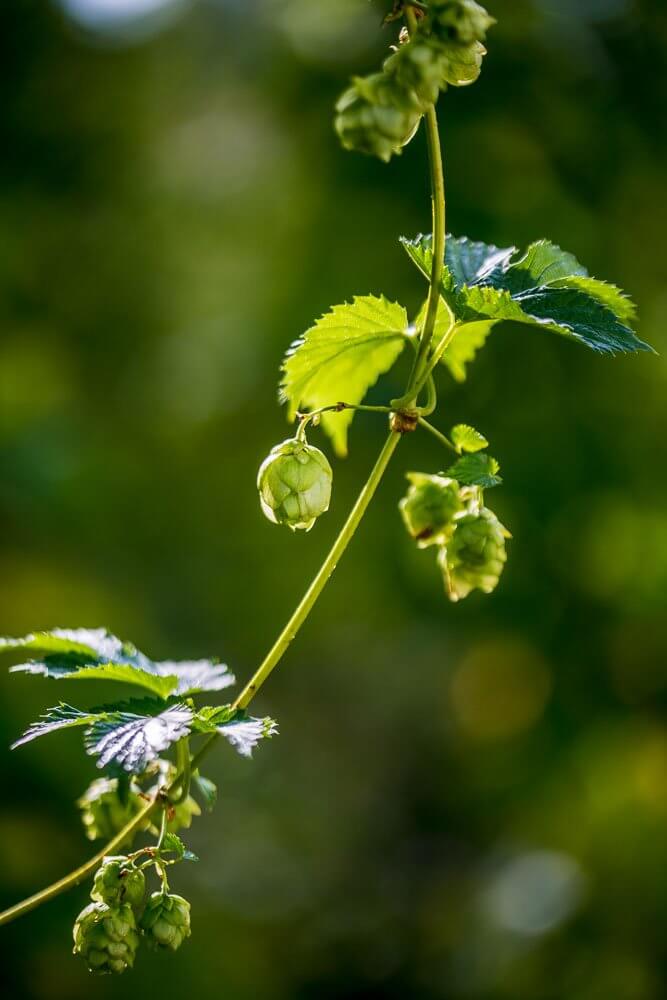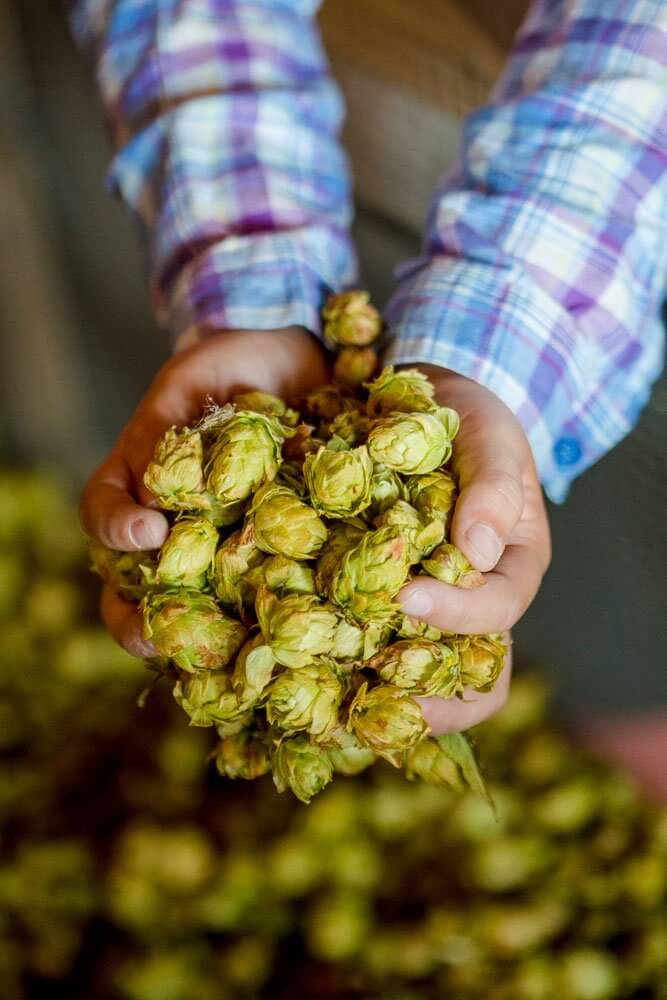
May 5, 2020
|
Rachel Keidan

It’s a clear September day as I drive north on Route 1 in Aroostook County and potatoes tumble upon rows of trellises covered in vibrant green hops vines, reaching taller than surrounding trees.out of the truck in front of me, bouncing to the side of the road like balls spilling from a bin. It’s hard to go a mile without spotting bags of the region’s hallmark crop for sale. But as I approach Westfield, about 9 miles south of Presque Isle, a less expected crop appears over the horizon: rows upon rows of trellises covered in vibrant green hops vines, reaching taller than surrounding trees.
“Most people haven’t seen it before,” says Krista Delahunty of her unusual crop. “So many people drive down this road just to look at it; it’s like a Sunday drive for people.”
Krista and her husband Jason Johnston own Aroostook Hops, one of the largest hops farms in Maine. They started the operation in 2009 and have since expanded from growing just 150 plants to more than 3,000 in five varieties. They sell their organic product to some of the largest breweries in the state, including Allagash and Gritty McDuff’s. With microbreweries popping up across the state, demand continues to in- crease for their bitter and aromatic harvest.
“If I called the farmers down the road right now and said, ‘Zach, I need a trailer,’ I’d have one in half an hour,” says Jason. He’s talking about his neighbor Zach Smith, owner of Smith’s Farm, the largest broccoli producer in New England. “The farming community here is fantastic. We couldn’t have done what we did without them.”
When I arrive at Aroostook Hops, the glow of the afternoon sun streams through the trellises. Jason and his crew of high school and college students busily run the harvesting machine, a boxy metal contraption made of several rows of loudly rattling rubber belts and metal claws that mechanically remove hops cones from vines— when all runs smoothly, that is. “The harvester has been really cantankerous today. It’s certainly not a perfect machine,” says Jason with a smile.
Still, the crew gets the job done. As they work, they’re surrounded on all sides by a distinct zesty aroma, one that I associate with pubs, not farm fields. The scent comes from a bright yellow substance called lupulin that coats the harvesting machine and the crew’s hands. Lupulin is what gives hops its distinct taste. It’s why brewers add hops to their beers, and can range in flavor from floral to citrus to spicy to bitter, depending on the variety. It’s mostly farmed for beer, but can also be found in various herbal remedies, the occasional restaurant dish, and soaps, which Krista and Jason make and sell on their website.
I take a quick turn picking leaves out of the harvest and get my own hands covered in sticky lupulin powder before Krista and I walk away from the commotion and out to some of the yet-to-be- harvested fields. Their two daughters, Kathleen and Marie, join us on the tour, along with baby Elise, who is currently strapped to Krista’s chest.




Jason and Krista rely on a seasonal crew to help tackle fall harvest tasks, from picking unwieldy vines to sorting and drying thousands of cones.
Crickets chirp noisily around us as we look down an impressive field of 40 rows of hops, each 250 feet long and about 20 feet high. “They grow so quickly, it’s incredible,” says Krista. She explains that they begin planting rhizomes in April, and by the second week in May, they train the plants to grow upward by wrapping them around lines hung from above. It’s labor-intensive to do the process manually but, once trained, the plants take off on their own. “By late June, they reach the top of the trellis and start making their side arms,” she explains.
The harvest season comes in a rush in August and September, when the cones are fully mature and have the right moisture content for optimal flavor. But Jason works full-time at the University of Maine at Presque Isle as an environmental science professor, and Krista also works part-time teaching an online biology course, so harvesting can only happen in the early mornings, evenings, and weekends. Pressures aside, they are glad to be part of this booming business, which they got into as a way to supplement their income and out of genuine interest in the biology of the hops plant.
“There is so much to know about it,” says Jason. Jason had dabbled in growing a couple of plants for homebrewing and then, on a winter’s day in 2009 (just a month after their first daugh- ter, Kathleen, was born), he and Krista started toying with the idea of expanding their crop—a notion they now attribute to the crazy ideas that grow like weeds during long Maine winters.
“We thought, well, the only way we can make any money off of this is to at least have an acre,” says Jason. “And then when we got to an acre, we realized that we really needed more gear and equipment and the only way to support that was to have at least 4 acres, which is where we are at now.”
For now, beers with Aroostook Hops are generally available on draft, and have included Gritty McDuff’s County Wet Hop and Geaghan Brothers’ Aroostook Hop Harvest, both IPAs.
Jason and Krista hope to eventually grow to a scale that would allow them to be in more bottles and cans, but first they need to be sure that they can consistently meet the demand of brewers they sell to. “The breweries have to know that year-round, they can get the same hops for their beer, for quality control,” Jason says. “Customers want their beer to taste exactly the same.”
After leaving the family with the sun setting on their front porch, I drive further north to Caribou. On their recommendation, I go to Northern Maine Brewing for dinner. The menu is not only great, they say, but this brewery uses Aroostook Hops in essentially all of its beers.
Chris Bell, co-founder of the brewery, says it was a no-brainer to use Krista and Jason’s hops in their brews as a way to support local business in The County, and because it’s a tasty product. “I love their hops, they are really very good,” he tells me as he serves me a flight.
I settle in and sip, enjoying the citrusy tanginess of my Maine Logger (a Pilsner-style lager with malt and “low hop bitterness”). This beer, matched with an order of potato-encrusted haddock served with a side of smashed pota- toes, showcases the best flavors to come from The County, all in one starchy, hoppy meal.
laura poppick is a freelance journalist based in Portland, Maine who covers science and
the environment. | laurapoppick.com

Krista Delahunty and Jason Johnson pose with their children, surrounded by hops vines. They have been growing hops on their Aroostook County farm since 2009.
Sign up for our monthly email newsletter.